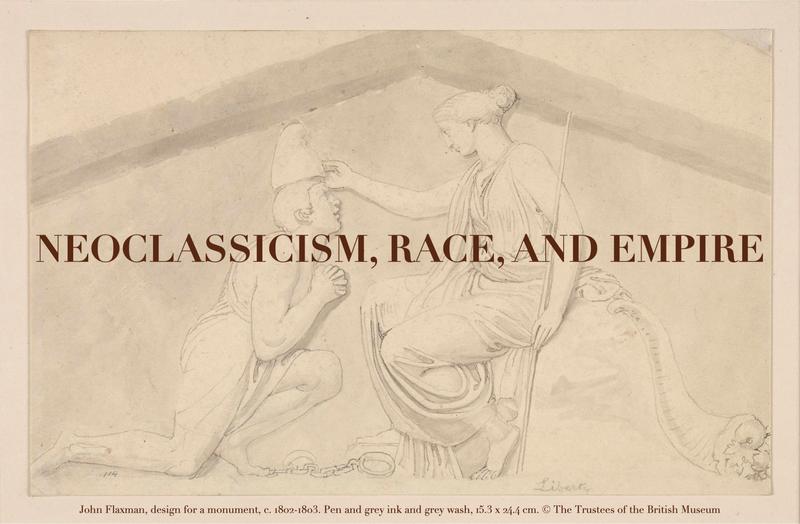Neoclassicism, Race and Empire - Charmaine A. Nelson

https://www.youtube.com/embed/uMLKXp2oSOs
Speaker: Professor Charmaine A. Nelson (NSCAD University)
This is the first of three events in the Neoclassicism, Race, and Empire seminar series.
This series examines the intersection between neoclassicism and questions of race, colonisation, empire-building, and national identity. With a focus on the British and French Atlantic worlds from the eighteenth century onwards, but with attention to a broader geographical field, we will ask how classical ideas and forms were invoked in art, architecture, and aesthetics in ways that intersected with colonial expansion, the assertion of imperial power, and the development of racial ideologies. Through a series of seminars led by pioneering scholars in this field, we will explore the stylistic phenomenon of ‘neoclassicism’ within its broadest political and cultural contexts, while discussing the longer historiographical legacy of self-consciously classical art made in the modern age of empire.
Charmaine A. Nelson is a Professor of Art History and a Tier I Canada Research Chair in Transatlantic Black Diasporic Art and Community Engagement at Nova Scotia College of Art and Design (NSCAD) University in Halifax, CANADA where she is also the founding director of the Institute for the Study of Canadian Slavery. Prior to this appointment she worked at McGill University (Montreal) for seventeen years (2003-2020) and at Western University for two (2001-2003). Nelson has made ground-breaking contributions to the fields of the Visual Culture of Slavery, Race and Representation, and Black Canadian Studies. She has published seven books including The Color of Stone: Sculpting the Black Female Subject in Nineteenth-Century America (2007), Slavery, Geography, and Empire in Nineteenth-Century Marine Landscapes of Montreal and Jamaica (2016), and Towards an African Canadian Art History: Art, Memory, and Resistance (2018). Nelson has given over 280 lectures, papers, and talks across Canada, and the USA, and in Mexico, Denmark, Germany, Italy, Norway, Spain, the UK, Central America, and the Caribbean. She is also actively engaged with lay audiences through her media work including ABC, CBC, CTV, BBC One, and PBS. She has blogged for the Huffington Post Canada and written for The Walrus. Nelson has held several prestigious fellowships and appointments including a Caird Senior Research Fellowship, National Maritime Museum, Greenwich, UK (2007), and a Fulbright Visiting Research Chair, University of California – Santa Barbara (2010). She was recently the William Lyon Mackenzie King Visiting Professor of Canadian Studies at Harvard University (2017-2018) and a Fields of the Future Research Fellow at Bard Graduate Center in New York City (2021).
“Male or Man?: The Politics of Emancipation in the Neoclassical Imaginary”
The strategic marginalization of black populations lay at the heart of Transatlantic Slavery. For black men this entailed a hyper-sexualization, criminalization, and animalization which sought to banish them from the category of manhood. To be owned and controlled by another – to be chattel – was as far away from western definitions of manhood as one could get. In the nineteenth century, how did this social, material, and political disenfranchisement impact their representation within the realm of neoclassical sculpture, a field in which many established American and European artists consistently represented enslaved black subjects? This lecture explores how white neoclassical sculptors sought to immobilize and infantilize black male subjects depicting the newly freed (recently liberated, formerly enslaved people), through compositional and aesthetic strategies which, even within the realm of abolitionist representation, standardly depicted the black male as socially and physically impotent. This symbolic visual denigration occurred even when they were depicted as fully-grown, physically powerful males. Through an exploration of the case studies of John Quincy Adams Ward’s Freedman (1863), Thomas Ball’s Lincoln Memorial (c. 1866), and Mary Edmonia Lewis’s Morning of Liberty/Forever Free (1867), this lecture examines whether any of these artists was able (or willing) to create sculptures which depicted enslaved black males gaining their freedom, as men.
Other seminars in the series:
Anne Lafont: Wednesday 16 March, 4pm – 5.30pm GMT (12pm – 1.30pm EST)
Louis Nelson: Wednesday 30 March, 4pm – 5.30pm BST (11am – 12.30pm EST)
Please note that in the USA and Canada, the session on 16 March starts an hour later than the others, because the clocks go forward on different dates.


